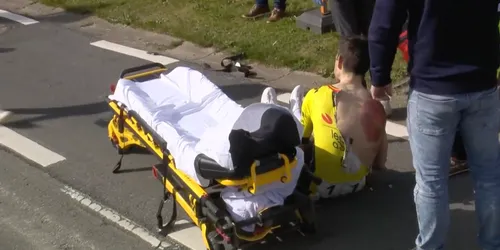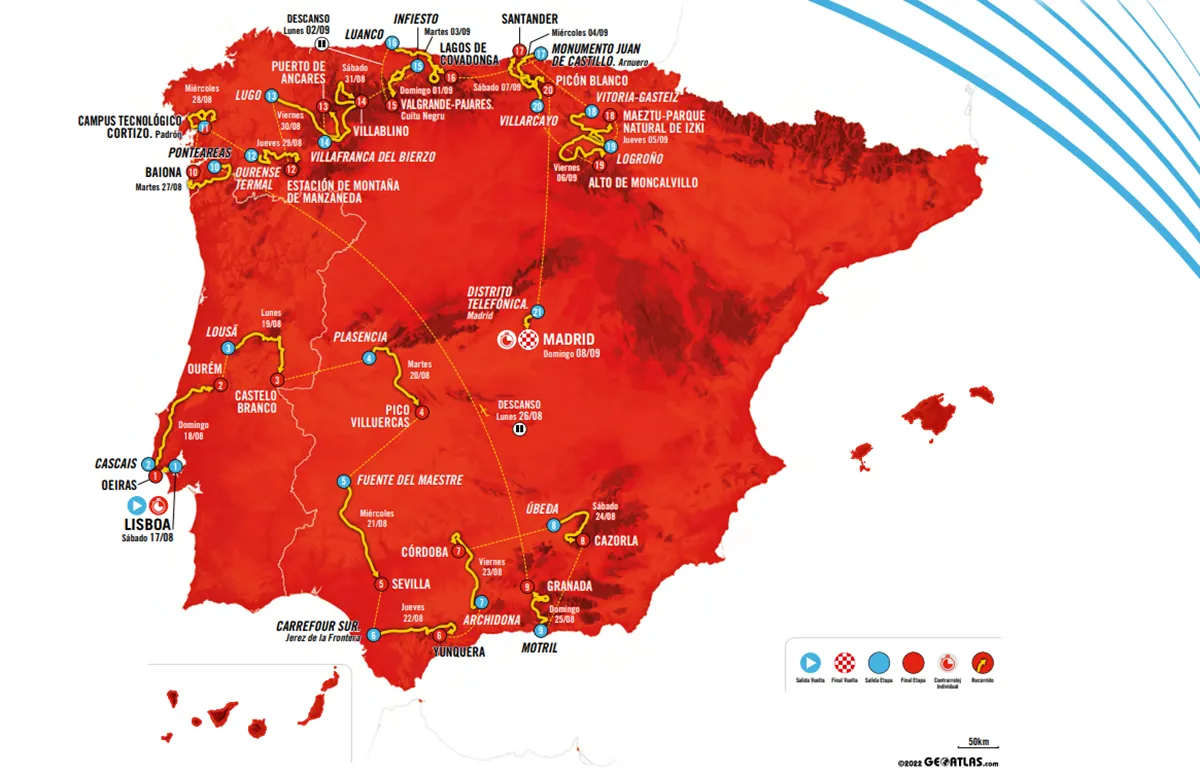
Wout van Aert’s 2024 season has been one of stark contrasts,
marked by both optimism and crushing setbacks. For a rider who has consistently
been among the best in the world, 2024 was supposed to be another chapter in a
story of success for van Aert. Yet, a horrifying crash at Dwars door Vlaanderen
in March abruptly changed the narrative.
What should have been a year defined by victories and
perhaps even new milestones turned into a battle against physical and mental
adversity. As Van Aert nears his 30th birthday, a milestone that traditionally
signals the beginning of the latter stages of an athlete’s prime, the 2024
Vuelta a España presents him with a crucial opportunity.
Not just to win stages or jerseys, but to rediscover the
form that made him a dominant force in cycling. Central to this opportunity is
the Vuelta’s points classification—a competition that could serve as both a
challenge and a catalyst for Van Aert’s resurgence.
Read also
The Crash that Changed Everything
The first part of 2024 held so much promise for Van Aert. He
claimed to be in the best physical condition of his career, which, considering
his past achievements, was a statement of immense potential. However, in one
terrifying moment at Dwars door Vlaanderen, everything changed. A high-speed
crash left Van Aert with seven fractured ribs, a broken collarbone, and a
fractured sternum. The injuries were severe enough to land him in the hospital
and force him to cancel his participation in the Giro d'Italia. The
psychological toll of such a crash, coupled with the long recovery process,
cannot be underestimated.
As Van Aert watched from the sidelines, his arch rival
Mathieu van der Poel dominated the spring classics, winning both the Tour of
Flanders and Paris-Roubaix. For a competitor like Van Aert, who thrives on the
biggest stages and against the toughest rivals, these victories by Van der Poel
were likely a bitter pill to swallow. They were a reminder of what could have
been—a painful contrast to his current reality of rehabilitation and missed
opportunities.

Wout van Aert crashed at the 2024 Dwars Door Vlaanderen
A Disappointing Tour de France
By the time the Tour de France rolled around in July, Van
Aert had recovered enough to compete, but it was clear he was not the same
rider who had electrified previous editions. In 2022, Van Aert was unstoppable,
winning three stages, wearing the yellow jersey for several days, and
dominating the points classification to claim the green jersey. He also rode his
teammate Vingegaard away from the mighty Tadej Pogacar, and was a key player in
the Dane’s overall victory. His performances were a masterclass in versatility,
showcasing his ability to win sprints, time trials, and even compete on
challenging terrain.
However, in 2024, Van Aert was a fraction of his former
self. He did not manage to secure a single stage win—a stark reminder of the
impact the crash had on his form and confidence. Van Aert was also unable to offer
the same level of support to Vingegaard, particularly on the mountain stages.
For a rider who has set such high standards for himself, the
2024 Tour was a humbling experience. It was a clear indication that while
physical recovery is one thing, returning to peak competitive form is an
entirely different challenge.
Read also
The Vuelta a España: Tailored for Van Aert
As Van Aert looks to the remainder of the season, the 2024
Vuelta a España offers a unique opportunity. The Vuelta is known for its gruelling
terrain, with stages designed to test the endurance and climbing abilities of
the world’s best riders. Unlike the Tour de France or the Giro d'Italia, the
Vuelta’s course is heavily skewed towards climbers and all-rounders, with far
fewer flat stages for sprinters to contest.
Spain’s mountainous landscape, is the perfect setting for
the Vuelta’s reputation as a climber’s paradise. The race organizers have a
penchant for designing stages that disrupt the general classification and
create time gaps. This philosophy often results in fewer sprint opportunities,
making the Vuelta a much more unpredictable and challenging race for sprinters.
In this context, the points classification at the Vuelta is
not the same as it is at the Tour de France or the Giro d'Italia. It’s a
competition that rewards consistency across a variety of stages, including
sprints, intermediate sprints, and even performances on hilly and mountainous
stages. This screams of the green jersey being worn by an all-rounder. For Van
Aert, this could be a golden opportunity.
Targeting the Points Classification: A Strategy for
Success
Van Aert is not just a sprinter; he is a rider with an
extraordinary range of skills. His ability to contest sprints, attack on hilly
terrain, and survive on mountainous stages gives him a unique advantage in the
Vuelta’s points classification. Unlike pure sprinters who may struggle to
survive the mountain stages and therefore miss out on valuable points, Van Aert
has the versatility to remain competitive throughout the entire race.
To successfully target the points classification, Van Aert
will need to adopt a strategic approach that maximizes his strengths while
managing his energy reserves. The Vuelta typically features only a handful of
flat stages where pure sprinters can dominate, so Van Aert will need to
capitalize on these opportunities to collect maximum points. However, the real
challenge—and opportunity—lies in the intermediate sprints and the stages that
end in reduced bunch sprints after hilly or mountainous terrain.
On such stages, where the sprinters’ teams may not be able
to control the peloton as effectively, Van Aert’s ability to navigate
challenging terrain and position himself for a strong finish could earn him
valuable points that others might miss. Additionally, Van Aert could target
breakaways on stages that don’t necessarily suit the pure climbers, aiming to
pick up intermediate sprint points and perhaps even challenge for stage wins.

Wout van Aert during the 2024 Olympic Games. @Imago
Psychological and Physical Rebuilding
Beyond the tactical considerations, the Vuelta represents a
crucial psychological and physical rebuilding phase for Van Aert. The crash at
Dwars door Vlaanderen and the subsequent underwhelming Tour de France have
undoubtedly taken a toll on his confidence. Competing for and potentially
winning the points classification would not only signal a return to form but
also restore Van Aert’s belief in his ability to compete at the highest level.
Winning the points classification at the Vuelta would
require Van Aert to deliver consistent performances over three weeks of intense
racing. This consistency is precisely what he needs to regain after the
disruptions of 2024. Each stage will serve as a test of his recovery, mental
resilience, and race craft—a process that, if successful, could lay the
foundation for a resurgent 2025 season.
Moreover, the Vuelta’s timing, as the last Grand Tour of the
year, means that a strong performance here could be the perfect springboard
into the offseason. It would allow Van Aert to finish 2024 on a high note,
turning what could have been a lost year into one of redemption and renewal.
Read also
A Career at a Crossroads
As Van Aert turns 30 in September, he stands at a crossroads
in his career. While 30 is not old in the world of professional cycling, it is
an age where many riders begin to think about the next phase of their careers.
The years of peak physical performance are limited, and the pressure to achieve
as much as possible in this window is immense.
The 2024 Vuelta a España, therefore, is not just another
race for Van Aert. It is a critical juncture where he can either reassert
himself as one of the peloton’s dominant forces or risk seeing his prime years
slip away. The points classification offers a tangible goal that aligns
perfectly with his abilities and the current state of his career. By focusing
on this competition, Van Aert can channel his frustrations and disappointments
into a targeted, achievable objective that could reignite his career.
Conclusion
Wout van Aert’s 2024 season has been a journey through
adversity, but the Vuelta a España offers a path to redemption. By targeting
the points classification, Van Aert has the chance to rediscover the form that
made him one of the most feared and respected riders in the world. The Vuelta’s
unique challenges will test every aspect of his ability, from his sprinting
prowess to his endurance on mountainous terrain.
In doing so, he can prove that even after the hardest falls,
champions can rise again—stronger, wiser, and more determined than ever. If Van
Aert can successfully navigate the Vuelta and emerge with the green jersey, it
will not only mark a significant achievement in his career but also serve as a
powerful statement: that Wout van Aert is far from finished, and that his best
days may still be ahead of him.
Read also
claps 2visitors 2
Just in
Popular news
Latest comments
- That's a lotta cash. He better live up to potential.mobk09-01-2026
- they be stupid Ineosabstractengineer09-01-2026
- Wow, sad and unlucky indeed if he can’t even cycle recreationally as a result of this.mobk09-01-2026
- That's right, Giannetti said that Almeida and Ayuso asked to go to the 2024 TdF. They told them that Tadej was the only captain then if they went, they would be domestiques. Both accepted. Almeida kept his word, but Ayuso was a traitor. As soon as he realized he couldn't play his game , hiding at the back of the peloto, watching his classification, he got "COVID" (in summer, at 40 °C), leaving his team with a man less.
 maria2024202409-01-2026
maria2024202409-01-2026 - if anyone can compete with Tadej and Mathieu that is.mij09-01-2026
- no one has an answer for those twomij09-01-2026
- sorry for him, must be toughmij09-01-2026
- just a boneheaded move to watch yates ride away in that initial 100m of his attack. it wasn’t that blistering. Del Toro and Carapaz just watched with no response.mij09-01-2026
- Health comes first on every occasion, for the sport this is disappointing I can't imagine how disappointing is for Eli. Wish him all the best.slappers6609-01-2026
- Starting all 3 vs finishing all 3, which makes what Sepp Kuss did in 2023 very impressive.
 Front24209-01-2026
Front24209-01-2026
Loading
🎞️ from 𝑨 𝑻𝑹𝑼𝑬 𝑹𝑬𝑵𝑨𝑰𝑺𝑺𝑨𝑵𝑪𝑬: Our Tour de France 2024 - Inside the Beehive Watch our documentary here: youtu.be/Iolscfq2K84
Write a comment















